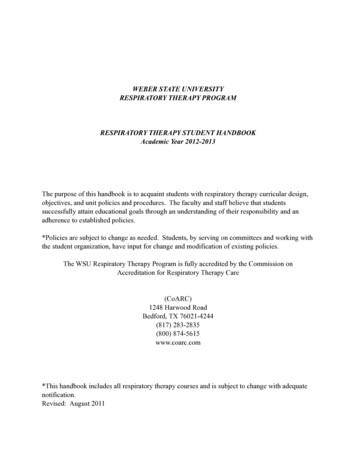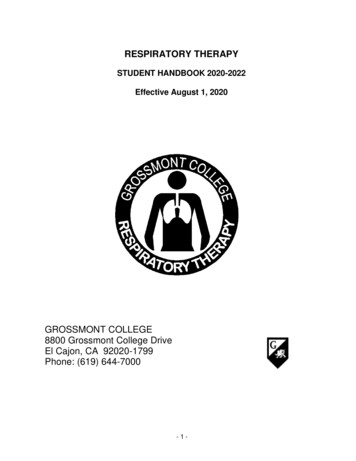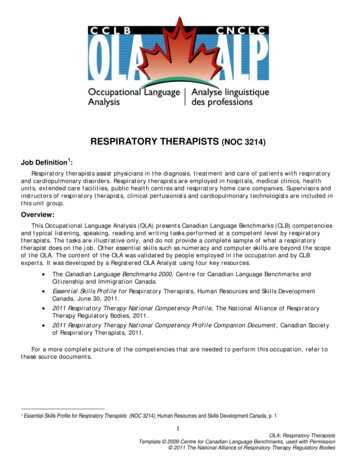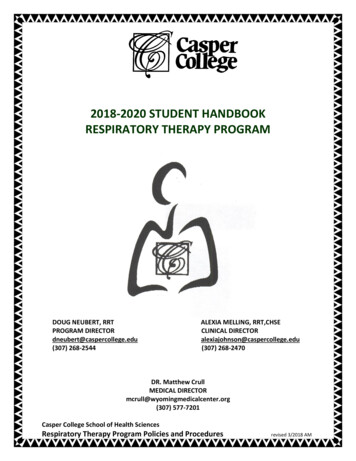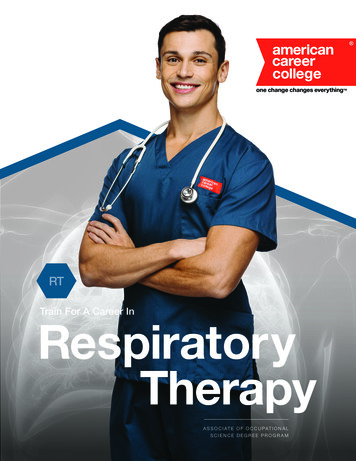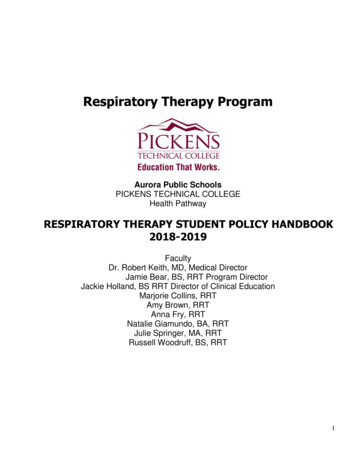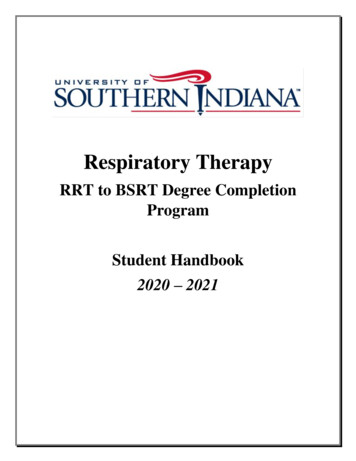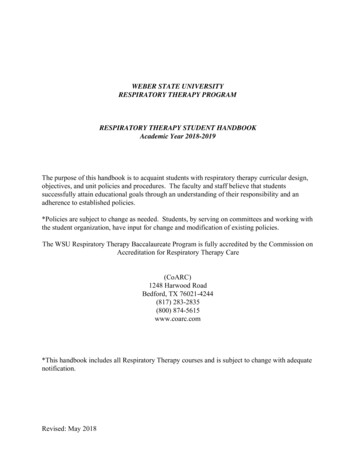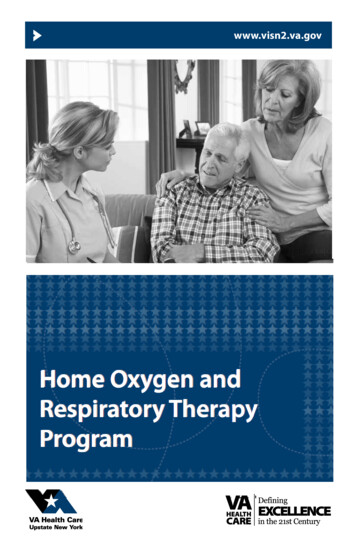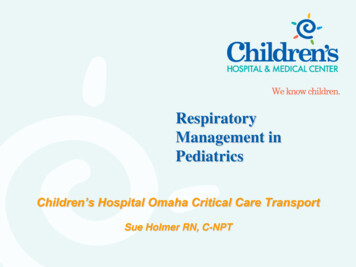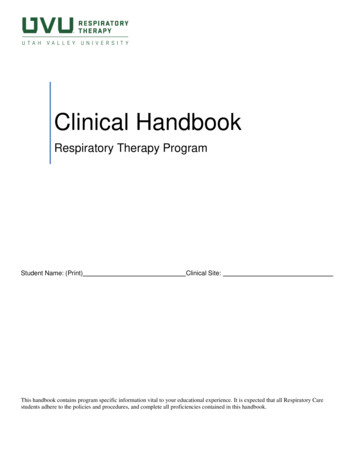
Transcription
Clinical HandbookRespiratory Therapy ProgramStudent Name: (Print)Clinical Site:This handbook contains program specific information vital to your educational experience. It is expected that all Respiratory Carestudents adhere to the policies and procedures, and complete all proficiencies contained in this handbook.
Respiratory Therapy ProgramIntroductionThe faculty of Utah Valley University welcomes you to your clinical rotation in respiratory care. Knowing thatknowledge is important, your involvement in this clinical experience will shape your future as a respiratory carepractitioner. It is imperative that you actively participate and immerse yourself in this clinical practicum. Yourrequirements may include extensive reading, individual assignments, group projects, and demonstration of anarray of clinical proficiencies throughout the clinical rotation. In addition to these requirements, you areexpected to demonstrate promptness, professionalism and an attire befitting of the profession that you areabout to embark. On behalf of the entire Respiratory Therapy faculty, I would like to thank you for acceptingthis challenge and the opportunity to be part of this experience as a respiratory therapy student.Respectfully:Kelly Rose, MSHS, RRT, AE-CDirector of Clinical Educaion,Respiratory Therapy Programkelly.rose@uvu.eduPage 2
Respiratory Therapy ProgramRespiratory Therapist General Duties Set up and operate devices such as mechanical ventilators, therapeutic gas administration apparatus, environmentalcontrol systems, and aerosol generators, following specified parameters of treatment.Provide emergency care, including artificial respiration, external cardiac massage, and assistance withcardiopulmonary resuscitation.Determine the requirements for treatment, such as type, method, and duration of therapy; precautions to take; andmedication and dosages compatible with physicians' orders.Monitor patient's physiological responses to therapy, such as vital signs, arterial blood gases, and blood chemistrychanges, and consult with physician if adverse reactions occur.Read prescription, measure arterial blood gases, and review patient information to assess patient condition.Work as part of a team of physicians, nurses and other health care professionals to manage patient care.Enforce safety rules and ensure careful adherence to physicians' orders.Maintain charts that contain patients' pertinent identification and therapy information.Inspect, clean, test, and maintain respiratory therapy equipment to ensure equipment is functioning safely andefficiently, ordering repairs when necessary.Educate patients and their families about their conditions and teach appropriate disease management techniques,such as breathing exercises and the use of medications and respiratory equipment.In addition to performing respiratory care procedures, respiratory therapists are involved in clinicaldecision-making and patient education. The scope of practice for respiratory therapy includes, but is notlimited to the: Acquiring and evaluation of clinical dataAssessment of the cardiopulmonary status of patientsAssisting and implementation of prescribed diagnostic studies such as arterial puncture and analysis, pulmonaryfunction testing, and polysomnographyEvaluation of data to assess the appropriateness of prescribed respiratory careEstablishment of therapeutic goals for patients with cardiopulmonary diseaseContribution, development, and modification of respiratory care plansEstablishment of case management initiatives for patients with cardiopulmonary and related diseasesInitiation of prescribed respiratory care treatments, evaluating and monitoring patient responses to such therapyand modifying the prescribed therapy to achieve the desired therapeutic objectivesRecommendation, initiation and administration of prescribed pulmonary rehabilitationPromotion and continued support of patient, family, and community educationPromotion and continued support of cardiopulmonary wellness, disease prevention, and disease managementParticipation of life support activities as required; and promoting evidence-based medicine; research; and clinicalpractice guidelinesFamiliarization of the various “Clinical Standards and Guidelines” presented by organization such as the AmericanAssociation of Respiratory Care (AARC), American Thoracic Society (ATS), University of Chest Physician (CCP)and other nationally known organizationsPage 3
Respiratory Therapy ProgramWhat do I Need to Bring to Clinical Rotations? StethoscopeUniform per University StandardID BadgesPenPharmacology cardsBandage ScissorsCalculator(battery powered)Clipboard/Pocket notebookWatch with second hand or digitalRequired reading material(clinical handbook, textbooks)Page 4
Respiratory Therapy ProgramAARC Statement of Ethics and Professional Conduct1In accordance with the “position statement,” AARC Statement of Ethics, and Professional Conduct fromthe American Association for Respiratory Care, “the conduct of the professional activities of all RespiratoryTherapist’s shall be bound by the following ethical and professional principles1.” Therefore, RespiratoryTherapists shall: Demonstrate behavior that reflects integrity, supports objectivity, and fosters trust in the profession and itsprofessionals.Seek educational opportunities to improve and maintain their professional competence and document theirparticipation accurately.Perform only those procedures or functions in which they are individually competent and which are within theirscope of accepted and responsible practice.Respect and protect the legal and personal rights of patients, including the right to privacy, informed consent, andrefusal of treatment.Divulge no protected information regarding any patient or family unless disclosure is required for the responsibleperformance of duty authorized by the patient and/or family, or required by law.Provide care without discrimination on any basis, with respect for the rights and dignity of all individuals.Promote disease prevention and wellness.Refuse to participate in illegal or unethical acts.Refuse to conceal, and will report, the illegal, unethical, fraudulent, or incompetent acts of others.Follow sound scientific procedures and ethical principles in research.Comply with state or federal laws that govern and relate to their practice.Avoid any form of conduct that is fraudulent or creates a conflict of interest, and shall follow the principles ofethical business behavior.Promote health care delivery through improvement of the access, efficacy, and cost of patient care.Encourage and promote appropriate stewardship of resources.Effective 12/94Revised 12/07Revised 07/09Revised 10/111AARC Statement of Ethics and Professional Conduct http://www.aarc.org/resources/position statements/ethics.htmlPage 5
Respiratory Therapy ProgramPolicies and Processes by which Students May Perform Clinical Work while Enrolled in the Program: EssentialFunctions / Core Performance StandardsSpecific health, physical and technical requirements are require from of all candidates challenging the RespiratoryTherapy program. The clinical practicum requires that each student be capable of demonstrating the following functions.The area of concern are defined by gross and fine motor abilities, physical strength and endurance, mobility, hearing,visual, tactile, smell, reading, arithmetic, emotional stability, analytical and critical thinking, interpersonal andcommunicative skills. Each student must carefully review the following descriptions and acknowledge their fullunderstanding of these requirements. In accordance with the American with Disabilities Act (ADA), the RespiratoryTherapy Program at Utah Valley University acts in accordance with all the standards. The attached EssentialFunctions/Core Performance Standards Worksheet provides the framework and categories that relate to anindividual’s functional ability, activities/attributes, and to any limitations/deficits of functional abilities that mayexist. The Respiratory Therapy Program shall implement these standards in combination with the professional scope ofpractice, job analysis, and expert consultation to make decisions related to the ability of the respiratory therapy student toperform the essential functions of respiratory care.Essential Functions / Core Performance Standards1. Gross motorability1.11.21.31.41.5Skills: Grasp, hold, and read smallinstruments such as volume measuringdevices. Lift medication vials to eyes toread. Record patient data in record orchange the settings on equipment byturning knob and observes change(s).Squeeze suction catheter button.Squeeze medication vials to empty. Writein patient chart.2. Fine motor ability2.1 Pickup objects with hands2.2 Grasp small objects with hands2.3 Write clearly and neatly with pen or pencil2.4 Type on a keyboard2.5 Pinch/squeeze or pick up objects2.6 Twist knobs with hands2.7 Possess manual dexterity for sterility andinfection control purposes.Skills: Change equipment settings abovehead and below waist. Function in anICU environment by moving about in anICU room in order to perform procedureson the patient. Student must also readpatient chart, equipment settings, and/orequipment displays. Sit or stand to recordfindings.3. PhysicalEndurance3.1 Stand at client’s side during procedure3.2 Sustain repetitive movements3.3 Maintain physical tolerance (continue tasksSkills: Bend to change equipmentsettings on floor, at knee level, waist level,chest level, eye level, or above head.Gather equipment and manuallyresuscitate patient. Make rapidadjustments if needed to ensure patientsafety. Make way to patient room if anemergency is called using stairs. Turn tochange settings on monitor while standingat patient bedsideMove within confined spacesSit and maintain balanceStand and maintain balanceReach above shouldersReach below waistthroughout a shift)3.4 Work and complete tasks at a reasonablepace4. Physical Strength4.1 Lift 25 pounds4.2 Carry equipment/supplies4.3 Squeeze with hands (e.g., use of a manualresuscitator)4.4 Able to push/roll 60 pounds4.5 Move heavy object weighing from 10-50pounds by using upper body strength.Page 6Skills: Procedures such as CPT andCPR require that you stand, move, andperform repetitive procedures on patientsthroughout the day. Repeat thisprocedure periodically throughout a shift.
Respiratory Therapy Program5. Mobility5.15.25.35.45.5TwistBendStoop/squatMove quicklyWalk and climb ladders/stools/stairsSkills: Help patient up in bed and fromstretcher to bed and back. Carrymedications, pulse oximeter,stethoscope, or other equipment topatient room. Push ventilator or otherheavy equipment from respiratory caredepartment to patient room. Liftequipment from bed height to shelf heightabove chest level.6. Hearing6.1 Hear normal and different speaking levelsounds6.2 Hear audible alarms6.3 Hear telephones6.4 Hear sounds with stethoscope(e.g., lungsand heart sounds)Skills: Hear audible alarms such as aventilator alarm. Hear overhead pages tocall for emergency assistance. Listen toheart sounds to determine if heart isbeating. Determine the intensity andquality of patient breath sounds in orderto help determine a diagnosis. Listen topatient breath sounds to determine ifpatient is breathing.7. Visual7.17.27.37.47.57.6Skills: Confirm settings visually such aswith ventilator display. Read patient chartto determine correct therapy. Readsettings on monitors and otherequipment. Visually assess patient colorto assess for hypoxia or any changes inpatient condition.8. Tactile8.1 Detect environmental temperature8.2 Detect temperature8.3 Feel the differences in sizes, shapes (e.g.palpate artery/vein)8.4 Feel vibrations (e.g. pulses)Skills: Assess patient by feeling forpulse, temperature, tactile fremitus,edema, subcutaneous emphysema.9. Smell9.1 Detect odors from client9.2 Detect smoke9.3 Detect gas or noxious smells (e.g. gas leakor smoke)Skills: Assess for unusual odorsoriginating from the patient orenvironment requiring attention.10. Reading10.1 Read and interpret physicians’ orders10.2 Read and understand written documents10.3 Read very fine or small printSkills: Read and interpret physicianorders and or physician, therapist, andnurse’s notes. Read from a computermonitor screen. Gather data accurately,and in a reasonable amount of time toensure safe and effective patient carerelative to other caregivers.11. Arithmetic11.1 Calibrate equipment11.2 Compute fractions11.3 Convert numbers to metric11.4 Count rates (e.g. pulses, breathing rate)11.5 Tell time and measure time (duration)11.6 Perform basic arithmetic functions add,subtract, multiply, divide11.7 Read and understand columns of writing(e.g. flow sheets)11.8 Read digital displays and graphic printouts11.9 Read graphs ( e.g. vital sign sheets,ventilator flowSkills: Read and interpret patientgraphics charts and graphic displays.Perform basic arithmetic functions inorder to calculate minute ventilation,convert temperature, correctly placegraduated tubing, and other functions.Distinguish colorDistinguish color intensitySee emergency lights/lampsSee object up to 20 inches awayUse peripheral visionVisually assess clientsPage 7
Respiratory Therapy Program11.10 Read measurement marks11.11 Record numbers ( chart observedparameters)11.12 Use a calculator11.13 Use measuring tools (e.g. thermometer,NIF, Peak Flow, VC)12. EmotionalStability12.1 Establish therapeutic boundaries12.2 Provide client with appropriate emotionalsupport12.3 Adapt to changing environment/stress12.4 Deal with the unexpected (e.g.emergency situations, trauma)12.5 Perform multiple responsibilitiesconcurrently12.6 Show appropriate compassion throughcommunicationsSkills: Provide for safe patient caredespite a rapidly changing and intenselyemotional environment. Perform multipletasks concurrently such as deliveringmedication or oxygen in one room whileperforming an arterial blood gas inanother (in an emergency room orgeneral floor environment). Maintainenough composure to provide for safeeffective patient care despite crisiscircumstances.13. AnalyticalThinking13.1 Evaluate outcomes13.2 Prioritize tasks13.3 Problem solve13.4 Process information13.5 Transfer/extrapolate knowledge from onesituation to another13.6 Use long and short term memorySkills: Evaluate priorities and differentsources of diagnostic information to helparrive at a patient diagnosis.Appropriately evaluate data in order tonotify physician and nurses whennecessary.14. Critical Thinking14.114.214.314.4Skills: Evaluate priorities and differentsources of diagnostic information to helparrive at a patient diagnosis andtreatment plan.15. Interpersonal15.1 Respect differences in clients15.2 Establish rapport with clients and coworkers15.3 Work effectively with physicians, staff,clients and their familiesSkills: Communicate effectively underany circumstance (courteous or offensive)with patients, families, doctors, nursesand other staff in order to meettherapeutic goals for the patient.16. Communication16.116.216.316.416.5Skills: Communicate effectively andappropriately with doctors, nurses,patients, family, and other staff in order toprovide for most effective and efficientpatient care.Identify cause-effect relationshipsPlan/control activities for othersSynthesize knowledge and skillsSequence informationConvey information through writingExplain procedure(s)Give oral reportsSpeak clearly and distinctlySpeak on the telephonePage 8
Respiratory Therapy ProgramClinical Requirements and Evaluation during Clinical ExternshipThere is a Dress Code Requirement for all clinical rotation / practicum’s due to of the environment in which a health careprovider practices. Each student must adhere to the following guidelines to ensure his/her safety and the safety of thepatients within the facility. The dress code states that:1. The student is expected to dress in appropriate attire for all clinical sessions as outlined below:1.1 The uniform consists of closed-toe and heel shoes, green and white scrubs with the school logo patch, plainwhite tee shirts worn under the scrub top (if a shirt is needed).1.2 The Utah Valley University and hospital issued picture IDs must appear in a visible part of the uniform at alltimes in the clinical setting.1.3 The uniform should always be clean and wrinkle free and the shoes and shoelaces free of a dirty appearance.2. When in uniform, jewelry must be kept to a minimum2.1 Earrings may not exceed one pair and must be small earrings for safety and aesthetic reasons.2.2 Limiting finger rings to plain wedding bands is an accepted practice2.3 Bracelets, necklaces, nose, tongue rings, or decorative pins are acceptable in the clinical settings3. When in uniform your fingernails are important.3.1 Nails are to be kept short at all times and without polish.3.2 The use of acrylic, decorative, or false nails increases the possibility harboring bacterial and fungal infections.Therefore, the use of these aesthetic does not comply with this dress code.3.3 The cuticles and area underneath the nail tips must be free of dirt or oil.4. Hair must be clean and pulled back from the face in a manner that prevents it from falling over the shoulders orcontaminate sterile fields while in uniform.4.1 Facial hairs need to be well groomed.5. Cosmetics and fragrances while in uniform.5.1 Perfumes or highly scented personal products are not be used because the fumes can cause breathingdifficulties to most patients.5.2 While in uniform, the student’s personal hygiene must be clean and free from body odor.6. No smoking or gum chewing during clinical/practicum time6.1 Most hospitals establish a smoke-free environment to within 250 feet of the hospital grounds.7. Eating, and/or drinking is allowed only in designated areas while at clinical/practicum.8. The hospital and/or the University reserve the right to require any student who is not correctly dressed to leavethe hospital.Page 9
Respiratory Therapy ProgramClinical Policies1. Make sure your clinical instructor knows where you are during clinical time, and if your assignment has changed fromits original arrangement, you must notify them accordingly.2. Before leaving your clinical site, notify your clinical instructor and make sure that he/she dismisses you from the clinicalsite and is aware of any incomplete assignments.3. Each student must document physician interaction time during each clinical rotation. Examples of this may includephysician rounds, teaching during invasive and non-invasive procedures, seminars, or formally structured meetingsconducted during your clinical rotation. This mandatory requirement is an excellent opportunity to enhance your learning.Notify your clinical instructor so they may help facilitate these educational opportunities. This is your responsibility.Contact with any specific physician should be documented in Trajecsys.4. The notice of privacy practices is a document that explains the confidentiality of patients and that all information isstrictly confidential. Breach of confidentiality will result in disciplinary action.5. Students may not conduct personal telephone calls or texting during clinical hours.6. If you become ill or are unable to attend your scheduled clinical shift, you must contact the facility at least TWOHOURS prior to your shift start time. You must also contact Kelly by text (801-473-8336). All missed clinical time mustbe made up during that same semester. Arrangements are to be made with the department manager.7. You should notify your clinical instructor if you become ill during your clinical time to consider the appropriate medicalattention and a course of action. You are required to make up all clinical time missed by making the necessaryarrangements with the department manager. You are responsible for costs incurred during treatment.8. Students will perform the psychomotor skills required of a respiratory therapist. Required proficiency checkoff evaluations will be used as an evaluation and grading guide for the psychomotor and cognitive skillsduring these and all clinical rotations. In addition, being punctual and actively participating each time is required.Dress code is essential as part of your affective behavior documentation. You must bring your school utensils suchas stethoscope, textbooks, notebook, calculator, blunt/bandage scissors, black pen and school / hospital ID. Pleaserefer to the list of “fundamental materials listed in this clinical handbook.9. In order to ‘pass’ any proficiency, the student must consistently perform the objective according to the acceptedprocedure standard. Each student must then continue to provide evidence of a ‘passing’ performance on objectivespreviously passed. Students, who are not capable of re-demonstrating these safe performances, may be re- assessed,suspended, or possibility termination from the clinical course and/or program.10. Students who consistently have trouble with their clinical skills must go to the campus lab for remediation. Studentsfailing to master any specific skill and or arrange to complete the necessary hours of clinical time will require academicadvisement and may be required to withdraw from the course.11. Each student must verbally communicate any tasks performed during their clinical rotation. This includes butmay not be limited to, patient diagnosis, history and physical, diagnostic testing, therapy outcomes and prognosis. Inaddition, you will have to complete a daily Clinical Activity Log that provides a detailed description of your clinicalobservations and activities for that particular day.Respiratory Clinical/Practicums: All students must pass the clinical performance evaluations, practical exams, andclinical case study analysis with the percentage of 75 (“C”) or above. Failure to achieve this threshold will requirethat the student repeat the practicum before advancing to any subsequent level.Page 10
Respiratory Therapy ProgramClinical Attendance and SchedulingThe clinical curriculum is competency based, thus, course completion requires demonstration of competence andproficiency in the performance of skills. Each clinical course has an established minimum number of clinical practicehours based on employer and graduate feedback, but additional hours may be required based on studentperformance.Students must notify (in advance) the faculty AND clinical agency of clinical schedule changes.Completion of designated clinical hours is mandatory for program completion. Clinical hours missed must be rescheduled and completed.Paid hours related to a student’ employment may not be used for clinical hour completion.All clinical hours completed for credit must be approved, prior to the experience, by the clinical faculty and must beassociated with outcome oriented objectives. Clinical credit is not given for travel time to and from clinical sites orfor associated classroom experience.Students may be assigned to clinical rotations at any of our affiliated institutions and during any shift (days,afternoon, or nights). It is the responsibility of the student to arrange for transportation to and from clinicalassignments. Under adverse driving conditions, if the student determines the road conditions to be too hazardousto travel, he/she is required to notify the appropriate faculty and make up the clinical day.Students are to note the disclaimer in the semester schedules, regarding clinical times/days, stating: “Please donot set up child care or work schedules based on the (semester schedule) printed clinical schedule. Updatedinformation will be provided at the Respiratory Therapy orientation for each campus.” Last minute changes aresometime unavoidable.Clinical TardinessTardiness in clinical is unacceptable and will be subject to faculty review. This reflects irresponsiblebehavior, lack of respect for faculty and to other students, and serves as a distraction to others. Clinicaltardiness may result in a failing clinical course grade.Clinical AbsencesRespiratory Therapy students must attend each clinical experience. In case of unavoidable absence on theassigned day, the faculty and the assigned clinical site must be notified, personally, prior to the student’sscheduled time. Calling the clinical site alone is not sufficient notice. Absences from clinical will be cause forreview by the faculty with possible failure for the semester and/or dismissal from the program. Absences will needto be rescheduled to make up the clinical day to allow for a passing clinical grade.Page 11
Respiratory Therapy ProgramClinical Absence With Proper NotificationProper notification means notifying the clinical supervisor at the assigned clinical site at least TWO hours priorto the scheduled beginning of the clinical shift.1st absence per clinical course no grade penalty.Any subsequent absences per clinical course one letter grade reduction for the course per absence.Clinical Absence Without Proper Notification1st absence per clinical course clinical course grade reduced one full letter grade2nd absence per clinical course clinical course grade of E.Under valid and extenuating circumstances a student may petition the faculty for an exception. Valid circumstancesfor missed clinical days could include student hospitalization, death of immediate family member, etc.If it is absolutely necessary to leave the clinical area early, the student must obtain permission from their assignedUVU clinical instructor prior to leaving the clinical setting. Missed clinical hours must be rescheduled to makeup the clinical practice day and to allow for a passing grade.In the event of student illness on a scheduled clinical day, the following options are available:a.All students should report personal illness or exposure to communicable diseases to his/herinstructor immediately. On a case-by-case basis, the instructor will determine if a student who is ill orhas been exposed to a communicable disease is able to continue to participate in the clinical area.b.If the student is disallowed from the clinical assignment, he/she must leave the clinical area and willbe listed as absent. Missed clinical hours will be required to be rescheduled to make up the clinicalday to allow for a passing grade.c.A physician’s release pertaining to health status may be required depending on origin of illness.Clinical practice days are the “glue” that pulls together and cements the theory and laboratory practice the studenthas already completed. They are also the opportunity for students to make a positive impression upon potentialemployers and colleagues. Whether a clinical day has been scheduled “traditionally,” or has been scheduleddirectly between a student and his/her preceptor, once the day has been scheduled, it is the student’s obligation tofulfill the scheduled day or notify the clinical instructor or preceptor. If you schedule a shift with a preceptor onSaturday, you may NOT just decide to go Sunday instead unless you have spoken directly with the preceptor tomake this change. Although hospitals are open 24 hours per day, they do NOT expect students unless scheduled,and they DO expect students when they are scheduled.Page 12
Respiratory Therapy ProgramResponsibilities of the Preceptor, Student, and Clinical Faculty(Developed using The Ohio State FNP Preceptor Orientation & School of Public Health)Responsibilities of the PreceptorThe preceptor should: Give the student an orientation to the site early in the experience. This will facilitate a smooth transition into thesite and optimize the use of available resources. Explain to the student your expectations of his or her conduct. The areas of dress, conduct, and generalcharacteristics of the experience should be discussed. Allow sufficient time for supervision and instruction in the form of routine interactions. Guide the student in his orher next steps and ask to review work periodically. Provide the student with constructive feedback. Afford the student the time and patience needed for an optimal learning experience. Facilitate physician interaction. Complete a daily evaluation and pass-off any completed competencies for that day in TrajecsysResponsibilities of the Student The student should function professionally and this should be reflected in the interaction, activities, andrelationships with the preceptor, patients and all facility staff. The student is expected to maintain confidentiality for all experiences. Students may describe experiences inclinical debriefing sessions, but statements of individuals are non-attributable and information will never becommunicated outside of the classroom. The student must:o Be professional in appearance, both in dress and conducto Adhere to the schedule agreed upon by the Clinical Facility Manager and UVU Director of ClinicalEducationo Be punctual and is required to notify the preceptor as soon as there is a possibility of being late or absent.o Practice professional courtesy when communicating with patients, families, and other health professionals.o Maintain appropriate confidentiality The relationship between the student and the preceptor should be one of student-teacher rather than employeremployee, or co-workers. The student-teacher relationship should be built on mutual trust, respect,communication, and understanding.Responsibilities of the UVU Faculty as related to Precepted Clinical ExperiencesEach student enrolled in the course is assigned a clinical faculty who: Assists the student in clarifying educational goals for the field experience Is responsive to the needs of the student and preceptor during the placement Completes at least one site visit per week that includes the student and preceptor. Is available by email and/or phone to discuss issues, concerns, and progress of the student throughout thesemester. Reviews all student evaluations and competencies as submitt
such as breathing exercises and the use of medications and respiratory equipment. In addition to performing respiratory care procedures, respiratory therapists are involved in clinical . decision-making and patient education. The scope of practice for respiratory therapy includes, but is not limited to the:
